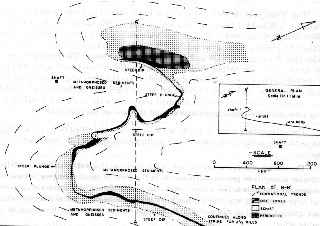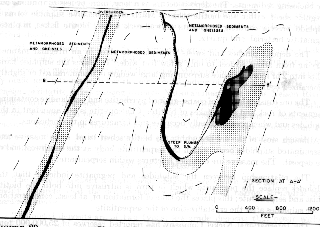Mining in Manitoba
Geology of the Thompson Area
GEOLOGY
 |
The nickel deposits mark the boundary between the Churchill and
Superior geologic provinces. The nickel belt is characterized by a series of gravity 'lows' adjacent to a high-gravity strip, greywacke-type
lithology, intense deformation, and a series of serpentinite intrusions.
These features extend along the entire belt and are characteristic of 'Alpine-type' mountain structure. It is probable that this zone of
Precambrian rock represents the roots of an ancient mountain system. The oldest rocks in the area appears to be a complex massive to gneissic body of hypersthene granite. Although contacts are not well exposed the younger sediments and gneisses presumably of the Churchill province appear to be faulted against the hypersthene granite. |
Volcanic rocks form only a minor part of the formations along the Thompson belt. They consist of fine to medium-grained metamorphosed andesite and/or basalt rarely showing signs of flow structure. It is possible that some of the exposures regarded as volcanic are actually fine-grained mafic intrusions.
Apart from the volcanic rocks the least altered rocks of the area are a series of sediments of the greywacke suite: greywacke, micaeous quartzite, argillite, and conglomerate and calcareous sediments. SOme of these are fresh, others are moderately metamorphosed; some bands of non-granitized gneiss, and some bands of pyroxene granulite mafic intrusions.
Large areas are underlain by partly granitized sedimentary gneiss, and granite gneiss containing inclusions of sedimentary gneiss. The sedimentary gneisses are well banded and composed of dominantly of quartz and feldspar. Some of the gneisses have a high garnet content, others contain abundant magnetite or cordierite. All of the gneisses have been injected and impregnated with varying amounts of granitic material.
Ultramafic and mafic rocks intrude the hypersthene granite, sediments, and gneisses intruded with younger granitic rocks. The most prominent of these intrusions are the serpentinite bodies with which the nickel deposits are associated. They occur as numerous more or less concordant intrusions. The serpentinite bodies are characteristically lenticular, of uniform composition, have a high Fe/Mg ratio and low CaO and Al2O3 contents. In these respects and their mode of occurrence they are typically Alpine-type serpentinite intrusions.
NICKEL DEPOSITS
The nickel deposits are of 2 types: low-grade deposits that occur within serpentinite bodies and at least one higher-grade deposit that occurs mainly in sedimentary rocks and gneisses. The high-grade Thompson deposit is associated with a small serpentinite intrusion and part of the ore occurs in this rock, however the majority of the sulphides occur in the adjacent sediments and schists.

Although most of the ore lies within the biotite schist band, some massive and disseminated sulphides occur within the serpentinite bodies. The massive sulphide ores occupy fractures in the serpentinite.

The relationship between the sulphides and pegmatites indicate that the sulphides replace the pegmatite which in turn is intrusive into both the biotite schist and serpentinite; this places the time of formation or, at least, the concentration, of the sulphides after the crystallization of the serpentinite.